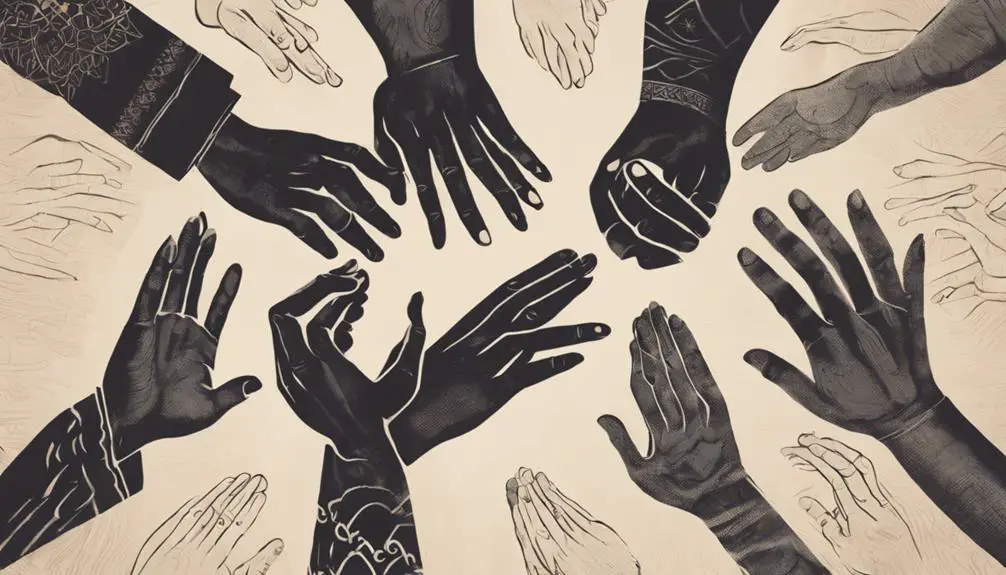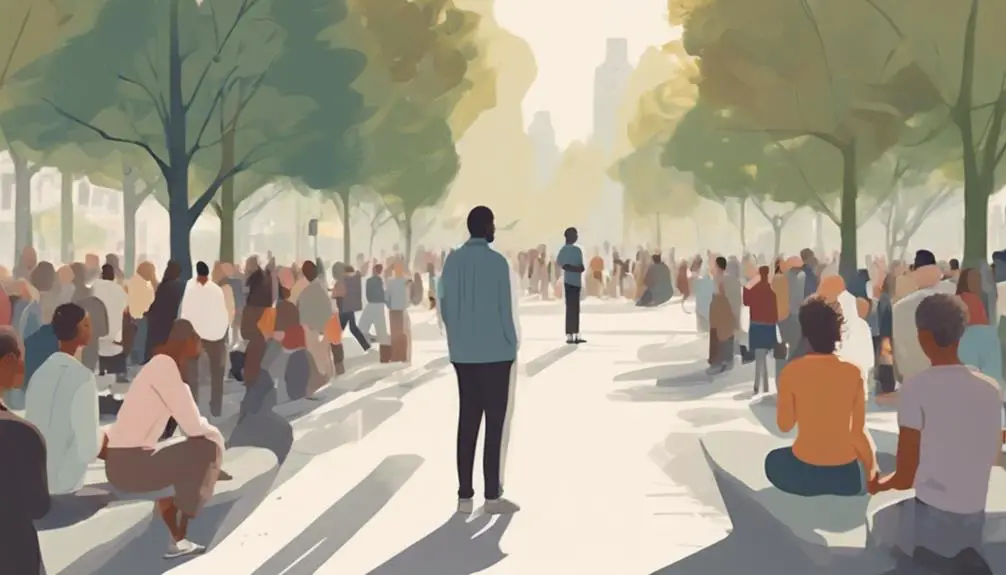Keep wondering if it's a sin to pray with your eyes open? Discover the truth behind this spiritual query and be enlightened.

Is It a Sin to Pray With Your Eyes Open?
While some may argue that the traditional posture of prayer involves closed eyes, you'll find that the essence of prayer goes beyond physical gestures.
You're about to explore a journey through historical perspectives, religious texts, cultural variations, and insights from religious leaders to understand if praying with your eyes open is considered a sin.
Along the way, we'll also uncover the practical considerations and unexpected benefits that might shift your perspective.
Get ready to engage in a conversation that bridges faith, tradition, and modern practice, leaving you equipped to form your own opinion on this nuanced topic.
Key Takeaways
- Prayer posture flexibility is essential for spiritual growth, not determined by sin.
- Religious texts and leaders emphasize heart condition over physical posture in prayer.
- Cultural and environmental influences allow for open-eyed prayer practices.
- Labeling specific prayer postures as sinful oversimplifies diverse faith journeys.
Historical Perspectives on Prayer

Throughout history, diverse cultures have embraced unique practices and beliefs surrounding prayer, revealing a rich tapestry of spiritual expression. The ritual origins of prayer vary widely, reflecting each society's worldview and its relationship with the divine. You'll find that prayer postures, in particular, hold significant meaning, often derived from ancient traditions that symbolize respect, humility, and openness to spiritual guidance.
Delving into the historical perspectives on prayer, it becomes evident that the physical stance during prayer—whether standing, kneeling, or with eyes closed or open—has been less about a rigid rule and more about the intent and heart posture towards the divine. This understanding challenges any simplistic notions of prayer practices being universally prescribed across cultures.
Moreover, the evolution of prayer postures over time underscores the adaptive nature of spiritual practices to social, environmental, and theological influences. For instance, the adoption of specific stances during prayer can be traced back to early human civilizations, where the physical acts were deeply intertwined with the community's collective identity and its understanding of the sacred.
In this light, examining the historical underpinnings of prayer sheds light on the myriad ways humans have sought connection with something greater than themselves, illustrating that the essence of prayer transcends specific postures or practices.
Examining Religious Texts
Delving into religious texts offers a profound insight into the nuanced perspectives on prayer practices, including the stance on keeping one's eyes open or closed during these sacred moments. These texts, revered by billions, often provide guidelines rather than strict rules about prayer postures, leaving a significant amount of interpretation to the individual or their spiritual guides.
Scriptural interpretations vary widely among and within traditions. For instance, some passages may emphasize the importance of humility and reverence in prayer, which can be symbolized by closed eyes and a bowed head. However, this isn't universally mandated. You'll find that many religious writings prioritize the heart's condition over physical posture. It's the sincerity and intent behind the prayer that most texts highlight as crucial, rather than the external form.
Moreover, references to prayer postures within these texts are often metaphorical, focusing on the spiritual posture one should adopt – such as openness, submission, and focus toward the divine. This indicates that while certain practices are recommended, there's room for personal or cultural interpretation.
Cultural Variations in Prayer Practices

Exploring the rich tapestry of global cultures reveals a diverse array of prayer practices, each deeply influenced by local traditions and beliefs. You'll find that gesture significance and environmental influences play critical roles in how communities engage with prayer.
In some cultures, specific gestures, such as the folding of hands or the direction one faces, carry profound spiritual meanings. These actions aren't merely physical; they're deeply rooted in the history and theology of the community, serving as physical embodiments of prayer intentions and beliefs.
Environmental influences also shape prayer practices significantly. For instance, in regions where nature is revered, you might find prayer practices that involve outdoor rituals or the use of natural elements like water, stones, or plants. These practices underscore a harmonious relationship between the divine, humanity, and the natural world, highlighting a community's belief in the interconnectedness of all things.
It's essential to approach these variations with respect and an open mind. Understanding that prayer practices are a reflection of a community's identity and spiritual journey allows for a deeper appreciation of the world's rich cultural and religious diversity.
Voices From Religious Leaders
Religious leaders from various traditions offer unique insights into the question of whether it's considered a sin to pray with one's eyes open, highlighting the diversity and depth of spiritual interpretations across cultures. These perspectives reveal that the essence of prayer isn't strictly bound to physical posture but is deeply intertwined with the intention and focus of the individual.
In many traditions, a specific prayer posture, including the position of the eyes, is less about the act itself and more about minimizing spiritual distractions. Leaders emphasize that the ultimate goal of prayer is to foster a profound connection with the divine, a process that might require different practices for different people. For instance, some find that closing their eyes helps shield them from immediate environmental distractions, aiding in deeper spiritual concentration. Others, however, might find open-eyed prayer more meaningful, especially when in the presence of nature or sacred imagery, which can enhance their spiritual experience.
The consensus among many religious leaders is that labeling any particular prayer posture as sinful oversimplifies the complex, personal journey of faith. They stress the importance of understanding individual needs and contexts, suggesting that flexibility in prayer practices, including whether one's eyes are opened or closed, can be essential for genuine spiritual growth.
Practical Considerations and Benefits

Considering practical considerations and benefits, it's crucial to recognize how different prayer postures, including whether one prays with eyes open or closed, can significantly impact spiritual engagement and focus. When you pray with your eyes open, you're not just adopting a posture; you're integrating focus techniques and environmental awareness into your spiritual practice. This approach can offer several benefits:
- Enhances Environmental Awareness: Keeping your eyes open during prayer can help you remain connected to your surroundings, fostering a sense of unity with the world around you. It allows you to incorporate the beauty and reality of your environment into your prayers, making your spiritual experience more grounded and immediate.
- Facilitates Focus Techniques: For some, open-eye prayer can aid in concentration. It can serve as a focus technique, helping to anchor your mind in the present moment and deter distractions, facilitating a deeper and more focused prayer experience.
- Adapts to Various Circumstances: Praying with eyes open offers flexibility, making it possible to pray in situations where closing your eyes mightn't be feasible or safe, such as while driving or in public spaces.
This analytical exploration reveals that integrating open-eye practices into prayer routines can offer unique advantages, enhancing both focus and environmental connection.
Frequently Asked Questions
Does Praying With Your Eyes Open Affect the Spiritual Energy or Connection During Prayer?
Praying with your eyes open doesn't necessarily affect your spiritual connection. It's more about cultural norms and personal comfort. Eye health isn't impacted, so you're free to choose what feels most spiritually fulfilling for you.
Are There Any Scientific Studies That Explore the Psychological Differences Between Praying With Eyes Open Versus Closed?
You're wondering if there are studies on praying with eyes open versus closed. Yes, research examining neural activity and attention focus reveals differences, offering insights into how our prayer practices may influence psychological states.
How Do Personal Testimonies of Individuals Who Pray With Their Eyes Open Differ From Those Who Traditionally Pray With Their Eyes Closed?
You'll find that personal testimonies vary greatly; those praying with eyes open often cite personal comfort and defiance of cultural norms, while closed-eye prayers may feel a deeper, more traditional connection to their spirituality.
In Emergency or Dangerous Situations, Is Praying With Eyes Open Considered More Acceptable or Even Advisable?
In emergency situations, cultural norms and historical perspectives often deem praying with your eyes open more acceptable, even advisable, reflecting a practical approach while maintaining spiritual focus amidst potential danger or immediate need for action.
Can Praying With Your Eyes Open Influence the Perception of Prayer in Public or Shared Spaces, and How Does It Impact the Privacy of One's Prayerful Intentions?
Praying with your eyes open in public spaces can challenge cultural norms and social acceptance, impacting how others perceive your prayerful intentions and potentially affecting the privacy and personal nature of your spiritual practice.
Conclusion
In conclusion, after exploring historical perspectives, religious texts, and cultural variations, alongside insights from religious leaders, it's clear that the act of praying with eyes open isn't universally viewed as a sin. Different traditions and interpretations offer flexibility in how prayer is approached.
It's important to respect these diverse practices and understand that the essence of prayer lies in sincere communication with the divine, rather than the physical posture or state adopted during the act.



Sign up